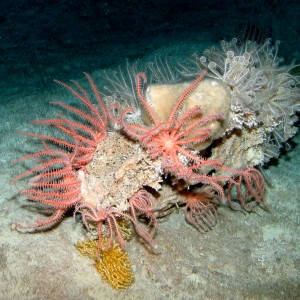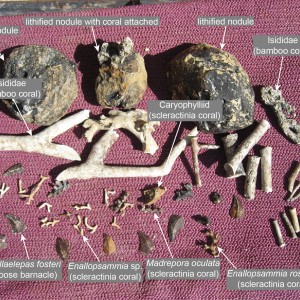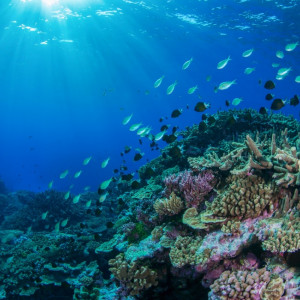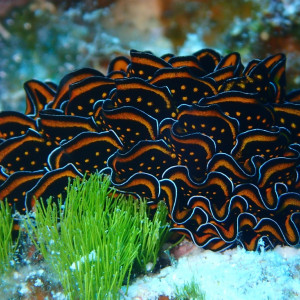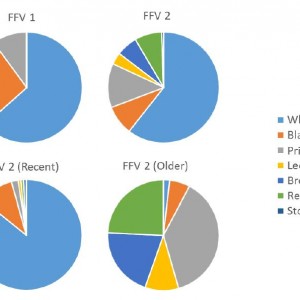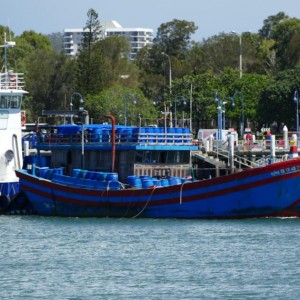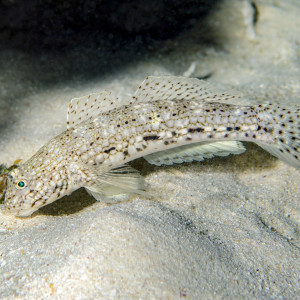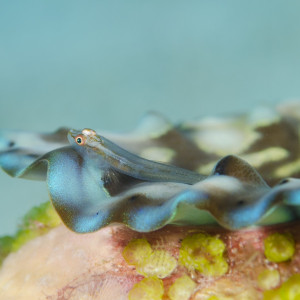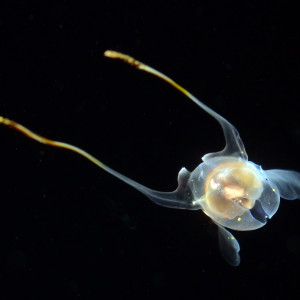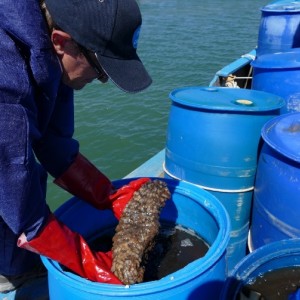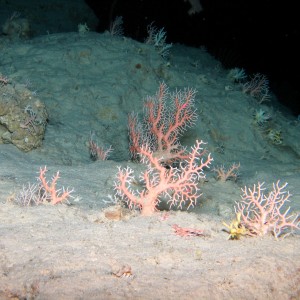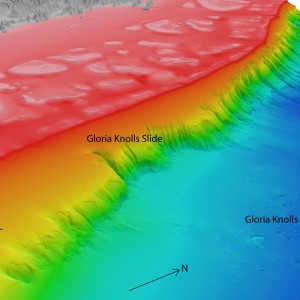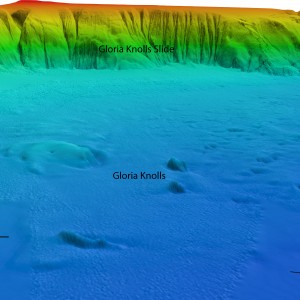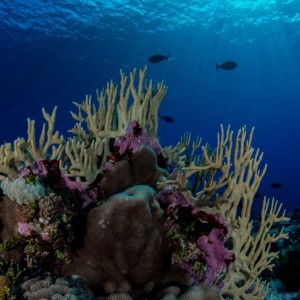A pinapple sea cucumber at Saumarez Reef in the Coral Sea Marine Park.
 by Reef Life Survey
by Reef Life SurveyBrisinglid sea stars photographed in the Coral Sea as part of the Deep Down Under research expedition. The Deep Down Under expedition was a team of German and Australian researchers exploring deep into the waters of Australia's Coral Sea in 2009. Geobiologists from the Ludwig-Maximilians-Universität Munich, the Natural History Museum at the Humboldt-Universität Berlin, the University of Göttingen, the Queensland Museum, University of Queensland and James Cook University investigated ‘living fossils’ such as sponges, brachiopods, echinoderms and cold-water corals in the deep. Using a 1000 m-rated Cherokee ROV from MARUM at the University of Bremen, the team explored the deep-sea ecosystems on the steep slopes of Queensland Plateau emergent reefs, such as Osprey Reef, which have remained largely unchanged for millions of years.
Changes in total fish biomass observed on reef transects associated with the 2016 heatwave (left), the 2020 heatwave (middle) and overall (right). The 2016 heatwave-associated fish biomass changes reflect the difference between values observed on surveys before 2016 versus after 2016 but before 2020. The 2020 changes reflect differences in values from after the 2016 event but before the 2020 event, versus after the 2020 event.

Changes in live hard coral cover associated with the 2016 heatwave (left), the 2020 heatwave (middle) and overall (right). The 2016 heatwave-associated coral changes reflect the difference between values observed on surveys before 2016 versus after 2016 but before 2020. The 2020 changes reflect differences in values from after the 2016 event but before the 2020 event, versus after the 2020 event. Changes in percent cover are absolute changes and do not depend on the initial cover, so a decline from 30% cover to 20% would be shown as a 10% decline.

Chromodoris elisabethina is a sponge-feeding nudibranch reaching up to 70mm in length. This individual was photographed on Lihou Reef in the Coral Sea Marine Park.
 by Graham Edgar
by Graham EdgarEvidence of the coldwater coral ecosystem recovered from the top of the largest of the Gloria Knolls, about 1200 metres underneath the ocean surface.
Colourful, complex, coral structures make up the shallow reefs at Bird Islet, Coral Sea
 by Rick Stuart-Smith
by Rick Stuart-SmithA ctenophore’s beating cilia refract light in stunning rainbow displays during a blackwater dive offshore of Marion Reef, within the Coral Sea Marine Park
 by Graham Edgar
by Graham EdgarCyerce nigrans is one of Australia’s sapsucking seaslugs. This brightly coloured individual was spotted on a Reef Life Survey transect in the Coral Sea Marine Park and is an iconic species of the Great Barrier Reef thanks to its bright aposematic colouration warning predators of its unpalatable secretions.
 by Graham Edgar
by Graham EdgarCatch composition by salted weight of sea cucumbers on two foreign owned and crewed fishing vessels apprehended in the Coral Sea. Foreign fishing vessel 2 was believed to have had two separate fishing episodes thus the ‘recent’ and ‘older’ terminology.
Foreign fishing vessel with sea cucumber cargo and tug.
 by Parks Australia
by Parks AustraliaA golden damselfish (Amblyglyphidodon aureus) at Mellish Reef in the Coral Sea Marine Park.
 by Reef Life Survey
by Reef Life SurveyIstigobius decoratus, known as the Decorated Sandgoby is found on sand patches near reefs.
 by Ian Shaw
by Ian ShawPleurosicya mossambica also known as the toothy goby or the Mozambique ghost goby is found on many substrates, including corals, sponges, giant clams and seaweeds, and can vary colour according to the substrate.
 by Ian Shaw
by Ian ShawA Pteropod, from the Greek meaning "wing-foot". These marine opisthobranch gastropods are specialised free-swimming pelagic sea snails and sea slugs. Most live in the top 10 m of the ocean and are less than 1 cm long.
 by Graham Edgar
by Graham EdgarThe exposed reef crest at Magdelaine Cay drops steeply into water over 500m deep
 by Graham Edgar
by Graham EdgarA Reef Life Survey diver, Anna Edgar, surveying Holmes Reef in the Coral Sea.
 by Reef Life Survey
by Reef Life SurveyA salp aggregate (Pegea confoederata) photographed offshore of Marion Reef in the Coral Sea Marine Park
 by Graham Edgar
by Graham EdgarA sea cucumber specimen found on an apprehended Foreign Fishing Vessel.
 by Parks Australia
by Parks AustraliaStylasterid corals photographed in the Coral Sea as part of the Deep Down Under research expedition. The Deep Down Under expedition was a team of German and Australian researchers exploring deep into the waters of Australia's Coral Sea in 2009. Geobiologists from the Ludwig-Maximilians-Universität Munich, the Natural History Museum at the Humboldt-Universität Berlin, the University of Göttingen, the Queensland Museum, University of Queensland and James Cook University investigated ‘living fossils’ such as sponges, brachiopods, echinoderms and cold-water corals in the deep. Using a 1000 metre-rated Cherokee ROV from MARUM at the University of Bremen, the team explored the deep-sea ecosystems on the steep slopes of Queensland Plateau emergent reefs, such as Osprey Reef, which have remained largely unchanged for millions of years.
A north-westerly view of the Gloria Knolls slide off Innisfail. Depths are coloured red (shallow) to blue (deep), over a depth range of about 1700 metres.
The Gloria Knolls landslide - a westerly view of the Gloria Knolls lying in the Queensland Trough downslope of the Gloria Knolls Slide. Depths are coloured red (shallow) to blue (deep), over a depth range of about 1500 metres.
A whitemouth moray eel, Gymnothorax meleagris, at Chilcott Islet in the Coral Sea Marine Park.
 by Reef Life Survey
by Reef Life SurveyA coral reef community in Coral Sea Marine Park. Still image taken as part of underwater visual census of marine life for the Reef Life Survey program. The Reef Life Survey program is a volunteer network of highly trained divers, and is a product of the CERF Major Projects funding that facilitated a cost-effective citizen science contribution to inventory and monitoring of shallow water marine environments. The RLS program has been further facilitated within the NERP Hub, describing biodiversity patterns at a national and global scale, as well as providing critical baseline data from areas such as the Coral Sea Marine Park, from Ashmore Reef, the Great Barrier Reef, and other Australian Marine Parks such as the Cod Grounds.
 by Reef Life Survey
by Reef Life Survey
